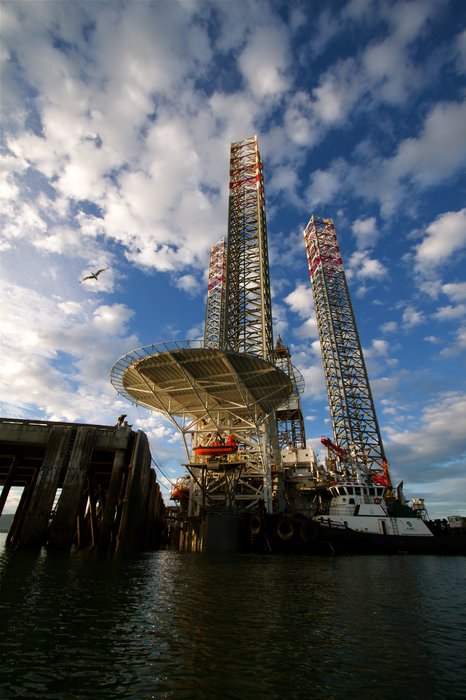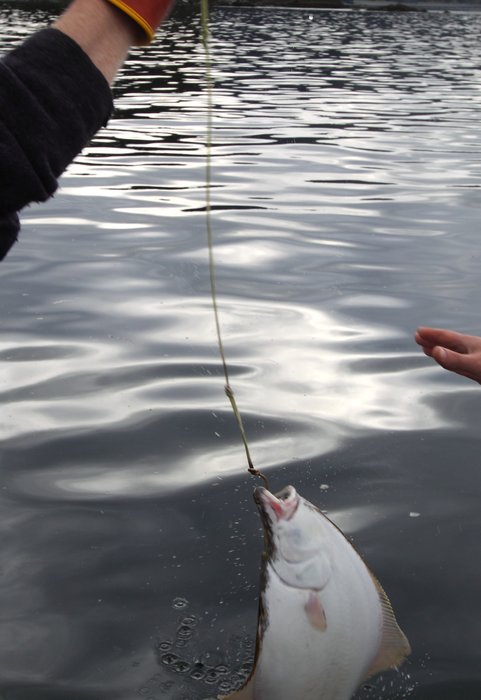Climate Change and Alaska Fisheries
Last modified: 13th February 2020


Executive Summary
As a fossil-fuel producing state, Alaska faces a tradeoff between developing its oil, gas, and coal resources (which will put more carbon dioxide into the atmosphere), and preserving its fish resources (which will be harmed by that carbon dioxide).
The burning of fossil fuels such as oil, gas, and coal releases large amounts of carbon dioxide into the atmosphere, which increases global temperatures and alters weather patterns. Some of this carbon dioxide is absorbed into the oceans, turning them more acidic. Both of those effects - climate change and ocean acidification - have profound implications for ocean ecosystems and the fisheries that Alaska depends on. These effects will lead to dramatic changes in many economically important fish species. Though fish populations may increase in some far northern habitats, the overall effects are overwhelmingly negative. Alaska’s cold shallow waters make it especially vulnerable to acidification. And salmon, one of Alaska’s most iconic and important species, are expected to suffer significantly from warming streams, warming oceans, and acidic waters.
Commercial fishing in Alaska is worth over $1.5 billion annually, counting only the “ex-vessel” value of the fish itself, as paid at the dock. Value-added processing in Alaska takes this number to $3.6 billion, and the inclusion of indirect and induced economic output brings the total to an estimated $5.8 billion. All of these activities provide tax revenue to the state and employment to residents. The most important species by monetary value are pollock, salmon, crab, Pacific cod, and halibut (in descending order), which together represent over 85% of commercial fishing dollars in Alaska.

Climate change and ocean acidification are predicted to impact Alaska fisheries in significant ways: shifting fishing grounds, which can move fish populations farther from ports or out of US waters; loss of habitat and food sources for commercially important fish; altered timing of salmon migrations; and stress to developing salmon from warmer streams. In many cases, these stresses can compound with other problems - fish weakened by warmer temperatures or lack of food become even more susceptible to predators and disease.
It is also possible that new fishing opportunities will appear in the far northern portions of the state. On the Arctic coast, species such as Arctic char and Dolly Varden are expected to benefit from warmer lakes and streams. Though these fish are eaten, they are not currently commercially targeted. But the few population increases that might come with warmer and acidified waters are unlikely to counterbalance the severe negative impacts to existing fisheries.
Ocean Acidification
The very same characteristics that make Alaskan fisheries so productive, namely cold and shallow waters, also allow Alaskan waters to absorb more carbon dioxide than most of the world’s oceans. A 2009 study led by Jeremy Mathis from the University of Alaska in Fairbanks has demonstrated that waters in the Gulf of Alaska are much more acidic than expected based on measurements in other oceans, and this matches similar findings in the Bering and Chukchi Seas.

Increasingly acid waters will weaken the shells of crabs and clams, potentially stressing their populations or increasing their vulnerability to predation. Shellfish fisheries will be directly impacted, as will subsistence harvesting. In Washington State, massive acidification-caused die-offs of oyster larvae are already having severe impacts on the shellfish industry. While fish such as salmon, halibut, and pollock are not directly affected by increasing acidity, their food supply will be. The tiny pteropod that makes up more than 50% of the pink salmon’s diet has been shown to be susceptible to carbon dioxide levels. Some sites in the Gulf of Alaska are already too acidic for pteropod shell formation. Additionally, studies on some fish species have shown that dissolved carbon dioxideimpairs their directional sense and ability to avoid predators.
Rising Ocean Temperatures
As the atmosphere warms, the ocean follows suit. Species adapted to cold water have been migrating north as southern waters warm, averaging a 12-mile range shift in the 24-year study period. This shift has been even greater for key commercial species such as halibut (34 miles), herring (24 miles), pollock (30 miles), and snow crab (55 miles). Such migrations may shift fish out of previously used fishing grounds or out of US waters. These shifts favor subarctic species over arctic species, which are squeezed into smaller potential habitats.

More profoundly, temperature can change ecosystems from the bottom up, with reverberating impacts on the entire food chain. In the Bering Sea, the base of the ecosystem is the spring bloom of plankton on the edge of the retreating ice. Much of this biological productivity ends up on the ocean floor, feeding clams and other bottom-dwelling creatures, and indirectly supporting the predators that eat them. When temperatures warm, the bloom of plankton occurs later, and instead of falling to the bottom, it is consumed by zooplankton within the water column, depriving the bottom-dwelling species of food. Bering Sea bottom-dwellers include commercially important species like crabs.
Although this shift potentially favors midwater species such as pollock, the effects of temperature can be complicated on even a single species. A warmer spring favors the development of young pollock larvae. But a warm autumn depletes their food source. Overall, warmer waters have been shown to result in fewer pollock surviving to the following year.

As young pollock are a prime food source for young salmon, continued warming is predicted to result in Bering Sea salmon entering winter with smaller food stores, reducing their survival to the following year. Upper ocean temperatures also impact the metabolic rates and respiration ability of salmon. In the high seas portion of their life cycle, salmon tend to be found within a fairly narrow range of ocean temperatures. Warming is expected to decrease the area that falls within this temperature range in the northern Pacific, while only marginally expanding the area within this range in the Arctic Ocean. As a result, the most favorable ocean habitats for salmon may shrink dramatically. Under a “medium” scenario for carbon dioxide emissions, a study comparing future ocean temperatures and the ideal temperature ranges for different salmon species predicted that ocean habitats for salmon may decrease by 29% to 86% by 2100, with the greatest losses in the Gulf of Alaska and the western and central subarctic North Pacific.
Freshwater Habitat
Freshwater fish or fish with a freshwater component to their life cycle (such as salmon) are impacted by stream temperatures, which can rise more quickly and more dramatically than ocean temperatures.
Increased productivity in arctic lakes and streams, and greater under-ice habitat in winter are predicted to benefit species such as Arctic char and Dolly Varden.

Salmon are one of Alaska’s most important fish, and in much of the state, the impact of warming streams is likely to harm them. Salmon are a cold water species. Temperature requirements vary between different salmon species and life stages, the most sensitive of which being egg incubation (harmed above 10°C, or 50°F) and smoltification (harmed in temperatures above 11-13°C, or 52-55°F). The state of Alaska has set water temperature criteriaat 13°C for spawning and incubation areas, and at 15° for rearing and migration areas. Cold water also holds more oxygen than warm water. High oxygen levels are necessary for successful incubation and hatching of salmon eggs, and for the metabolism of adult salmon.
Temperatures have been rising in streams around the state. In Cook Inlet, nonglacial salmon streams (the clear water habitat where most salmon spawn and rear) consistently exceed Alaska’s water quality criteria set for the protection of fish, and stream temperatures are strongly correlated with air temperature. Using historical air temperature information, it is clear that stream temperatures are warmer now than in the recent past. Since 1949, air temperatures in Alaska have risen an average of 3 °F (1.6 degrees C), more than twice the world average, and are expected to continue rising quickly.

These rising temperatures also affect the timing of salmon migrations. Many salmon runs have begun earlier in the spring or later in the fall in response to warming temperatures. In Auke Creek, near Juneau, a study showed that this was a genetic change in the salmon population, with natural selectionreducing the numbers of late-migrating fish in favor of those with an earlier spring migration time. In 40 years, the migration time has shifted by two weeks, and the stream temperature has risen by 1°F. Temperature is rising much faster now than at the beginning of that time period, in the 1970s. It is unclear how quickly migration timing will shift, whether it will be matched with the timing of salmon food sources, and what the ultimate impacts on population will be.
Warming may also allow salmon tomove into areas of the Arctic where they are not currently found. However, even with warming summer temperatures, limited overwintering habitat, spawning habitat, and nearshore habitat will limit large scale colonization in the near term.
Conclusion:
The climate change impacts to Alaska fisheries should be a key consideration in state decisions over development of fossil-fuel (carbon dioxide producing) resources, and fossil fuel consumption. It will also prove extremely important in fisheries management. Shifting conditions in the ocean and streams will likely make management more challenging, as managers try to adequately predict and preserve populations of fish that are also being pressured by climate change impacts.
Created: Jan. 19, 2018